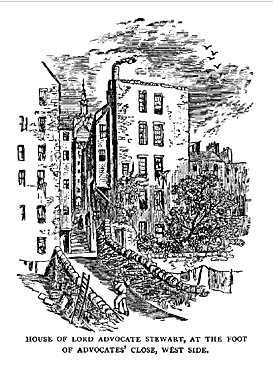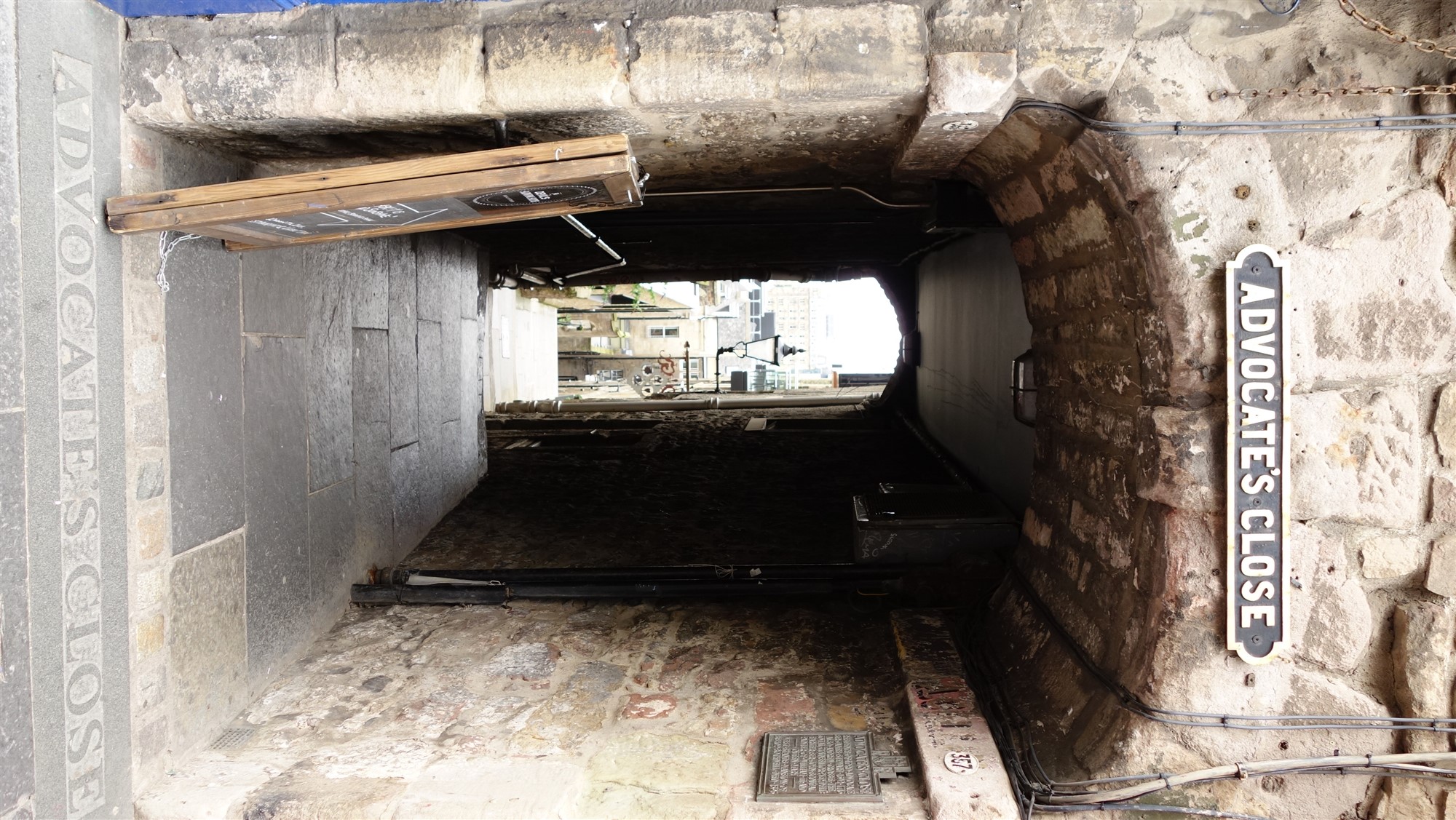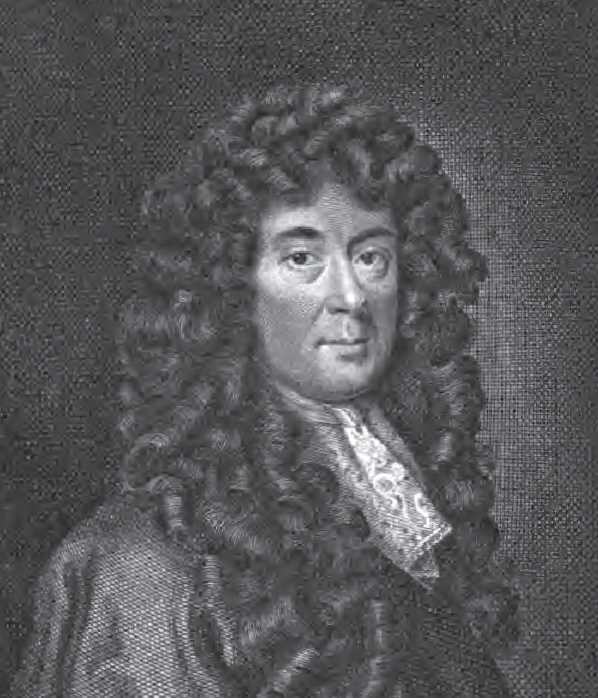|
James Stewart (advocate, Born 1635)
Sir James Stewart (or Steuart) of Goodtrees (1635–1713) was a Scottish lawyer, political opponent of the Stuarts monarchy, and reforming Lord Advocate of Scotland from 1692 to 1713. The Jacobites nicknamed him Jamie Wylie. Early life James Stewart was the fourth son of Sir James Steuart of Coltness (1608–1681), a banker in Edinburgh and Lord Provost of Edinburgh, and Anne Hope, niece of Sir Thomas Hope. He was the brother of Sir Robert Steuart, 1st Baronet of Allanbank (1643–1707) and Sir Thomas Stewart of Coltness, 1st Baronet. Career He was called to the bar on 20 November 1661, but lost almost all his practice defending his father against a charge of embezzlement. In exile Stewart found it necessary to leave the country because of a pamphlet, and went to Rouen, where he became a merchant under the name of Graham. Some years afterwards he returned to Scotland, but he was suspected of having had a hand in a further political pamphlet, ''An Account of Scotland ... [...More Info...] [...Related Items...] OR: [Wikipedia] [Google] [Baidu] |
John Baptist Medina
Sir John Baptist Medina or John Baptiste de Medina (1659 – 5 October 1710) was an artist of Flemish people, Flemish-Spanish origin who worked in England and Scotland, mostly as a portrait painter, though he was also the first illustrator of ''Paradise Lost'' by John Milton in 1688. Life and portrait-painting Medina was the son of a Spanish army captain posted to Brussels, where he was born and later trained by François Duchatel, before coming to London in 1686 and setting up his studio in Drury Lane. Even in London he seems to have specialized in Scottish sitters, and in either 1688–89 or 1694 he moved to Edinburgh at the invitation of David Leslie, 3rd Earl of Leven.Duncan Macmillan (art historian), Macmillan, Duncan (1984), ''Scottish Painting 1500 - 1700'', in Hearn, Sheila G. (ed.), ''Cencrastus'' No. 15, New Year 1984, pp. 25 - 29, He remained there for the rest of his life. He was encouraged and sponsored by George Melville, 1st Earl of Melville, the Earl of M ... [...More Info...] [...Related Items...] OR: [Wikipedia] [Google] [Baidu] |
The Hague
The Hague ( ; nl, Den Haag or ) is a city and municipality of the Netherlands, situated on the west coast facing the North Sea. The Hague is the country's administrative centre and its seat of government, and while the official capital of the Netherlands is Amsterdam, The Hague has been described as the country's de facto capital. The Hague is also the capital of the province of South Holland, and the city hosts both the International Court of Justice and the International Criminal Court. With a population of over half a million, it is the third-largest city in the Netherlands, after Amsterdam and Rotterdam. The Hague is the core municipality of the Greater The Hague urban area, which comprises the city itself and its suburban municipalities, containing over 800,000 people, making it the third-largest urban area in the Netherlands, again after the urban areas of Amsterdam and Rotterdam. The Rotterdam–The Hague metropolitan area, with a population of approximately 2.6&n ... [...More Info...] [...Related Items...] OR: [Wikipedia] [Google] [Baidu] |
Robert Traill Of Greyfriars
Robert Traill of Greyfriars was born at Denino, in 1603. He was son of Colonel James Traill, of Killcleary, Ireland, Gentleman of the Privy Chamber to Henry, Prince of Wales, and grandson of the Laird of Blebo, and Matilda Melvill of Carnbee. He graduated with an M.A. from St Andrews on 21 July 1621. he went over to Paris, and subsequently joined his brother in Orleans. He later studied at the Protestant College of Saumur. He was an English tutor in France to the sister of the Duke of Rohan in 1628. He was afterwards teacher in a school established by a Protestant minister at Montague, in Bus Poitou. He became chaplain to Archibald, Marquess of Argyll (beheaded 1661). In 1630 he returned to Scotland. He was ordained to Elie 17 July 1639. In 1640, he was ordered to attend Lord Lindsay's regiment at Newcastle for three months. He was chaplain to the Scots army at Marston Moor in 1644. He was elected by the Town Council 7 November 1648. He became minister at Old Greyfriars on ... [...More Info...] [...Related Items...] OR: [Wikipedia] [Google] [Baidu] |
Andrew Honeyman
Andrew Honeyman or Honyman (1619–1676) was a Scottish priest: he was Bishop of Orkney from 1664 until 1676. Life He was born in 1619, the son of David Honeyman of Pitairchney, a baker of St Andrews. His brother was Rev Dr Robert Honyman DD, minister of St Andrews. He was a graduate of the University of St Andrews in 1635, and was presented to the parish of Ferry-Port on Craig in 1641. In 1664 he succeeded Thomas Sydserf as Bishop of Orkney based at Kirkwall Cathedral. Answering ''Naphtali'', a Covenanter pamphlet of 1667, Honeyman became involved in a polemic exchange with James Stewart, one of the presumed authors. He was injured in the arm in the assassination attempt made by James Mitchell on James Sharp on 9 July 1668. He died at Kirkwall on 21 February 1676. He is buried in Kirkwall Cathedral. His position as bishop was filled by Murdoch MacKenzie. Family He married firstly Sept. 1642, Euphan (died 27 March 1668), daugh. of Samuel Cunningham, min. of Ferry-P ... [...More Info...] [...Related Items...] OR: [Wikipedia] [Google] [Baidu] |
Pentland Rising
The Battle of Rullion Green took place on 28 November 1666, near the Pentland Hills, in Midlothian, Scotland. It was the only significant battle of the Pentland Rising, a brief revolt by Covenanter dissidents against the Scottish government. Sparked by opposition to the restoration of episcopalianism in the Church of Scotland, a Covenanter army under Colonel James Wallace was defeated by a government force led by Tam Dalyell of the Binns. While casualties were relatively light, between 40 to 50 Covenanters were killed and up to 85 prisoners taken, many of whom were alleged to have been tortured. 36 were executed and others transported to Barbados, while unrest continued over the next two decades, culminating in the extended period of repression from 1679 to 1688 known as The Killing Time. Background After the Restoration of the Monarchy in 1660, the Rescissory Act 1661 restored bishops to the Church of Scotland, or kirk. Ministers were required to renounce the 1638 National ... [...More Info...] [...Related Items...] OR: [Wikipedia] [Google] [Baidu] |
Advocates Close
Advocates Close is a narrow and steep alley in Edinburgh of medieval origin, redeveloped in the early 21st century. With a multiplicity of steps it is not accessible to disabled persons. The close leads from Market Street at the foot of Cockburn Street to the Royal Mile, exiting opposite St Giles Cathedral close to the Supreme Court of Scotland. Viewing from the Royal Mile down the close it frames a view of the Scott Monument. History The street dates from at least the 15th century, and elements survive from at least the mid-16th century. At this time the street was a fashionable address, where the Scottish gentry and professionals would live with their family and servants. The name derives from the house of Sir James Stewart who was Lord Advocate of Scotland. Adam Bothwell's house stands on the west side of the close and was originally accessed from Byers Close. By the 19th century the Edinburgh gentry had abandoned the Old Town and moved to the New Town or suburbs. Street ... [...More Info...] [...Related Items...] OR: [Wikipedia] [Google] [Baidu] |
Greyfriars Kirkyard
Greyfriars Kirkyard is the graveyard surrounding Greyfriars Kirk in Edinburgh, Scotland. It is located at the southern edge of the Old Town, adjacent to George Heriot's School. Burials have been taking place since the late 16th century, and a number of notable Edinburgh residents are interred at Greyfriars. The Kirkyard is operated by City of Edinburgh Council in liaison with a charitable trust, which is linked to but separate from the church. The Kirkyard and its monuments are protected as a category A listed building. History Greyfriars takes its name from the Franciscan friary on the site (the friars of which wear grey habits), which was dissolved in 1560. The churchyard was founded in August 1562 after Royal sanction was granted to replace the churchyard at St Giles' Cathedral in Edinburgh. The latter burial ground was not used after around 1600. The Kirkyard was involved in the history of the Covenanters. The Covenanting movement began with signing of the National Cov ... [...More Info...] [...Related Items...] OR: [Wikipedia] [Google] [Baidu] |
Thomas Aikenhead
Thomas Aikenhead ( bapt. 28 March 1676 – 8 January 1697) was a Scottish student from Edinburgh, who was prosecuted and executed at the age of 20 on a charge of blasphemy under the Act against Blasphemy 1661 and Act against Blasphemy 1695. He was the last person in Great Britain to be executed for blasphemy. His execution occurred 85 years after the death of Edward Wightman (1612), the last person to be burned at the stake for heresy in England. Early life Thomas Aikenhead was the son of James Aikenhead and Helen Ramsey. His father was a burgess of Edinburgh, as was his paternal grandfather (also named Thomas Aikenhead). His maternal grandfather was a clergyman. He was baptized on 28 March 1676, the fourth child and first son of the family. Of his three older sisters (Jonet, Katherine, and Margaret), at least one and possibly two died before he was born. Indictment During his studies at the University of Edinburgh, he engaged in discussions regarding religion with his fri ... [...More Info...] [...Related Items...] OR: [Wikipedia] [Google] [Baidu] |
Dean Of The Faculty Of Advocates
The Dean of the Faculty of Advocates, also known as the Dean of Faculty, is the head of the Faculty of Advocates, the independent body for advocates in Scotland. The Dean is elected by the whole membership. List of deans of Faculty * 1582 to ????: John Sharp 17th-century * 1655 to ????: John Nisbet * 1661 to ????: John Ellis of Elliston * 1664 to ????: Robert Sinclair of Longformacus * 1672 to ????: George Lockhart * 1675 to ????: Sir Andrew Birnie. Later Lord Saline. * 1680 to ????: Sir John Dalrymple * 1682 to 1689: George Mackenzie of Rosehaugh * 1690 to ????: Sir John Dalrymple * 1691 to ????: Sir Robert Colt * 1694 to 1695: Sir James Stewart * 1695 to 1698: Hew Dalrymple * 1698 to >1708: Robert Bennet 18th-century * 1698 to >1708: Robert Bennet * 1712 to 1721: Sir David Dalrymple * 1721 to 1722: Robert Dundas of Arniston, the Elder * 1722 to 1746: ?? * 1746 to 1760: Robert Dundas of Arniston, the younger * 1760 to 1764: James Ferguson * 1764 to 1775: Alexander Lockh ... [...More Info...] [...Related Items...] OR: [Wikipedia] [Google] [Baidu] |
Glorious Revolution
The Glorious Revolution; gd, Rèabhlaid Ghlòrmhor; cy, Chwyldro Gogoneddus , also known as the ''Glorieuze Overtocht'' or ''Glorious Crossing'' in the Netherlands, is the sequence of events leading to the deposition of King James II and VII of England and Scotland in November 1688, and his replacement by his daughter Mary II and her husband and James's nephew William III of Orange, de facto ruler of the Dutch Republic. A term first used by John Hampden (1653–1696), John Hampden in late 1689, it has been notable in the years since for having been described as the last successful invasion of England as well as an internal coup, with differing interpretations from the Dutch and English perspectives respectively. Despite his personal Catholicism, a religion opposed by the Protestant majority in England and Scotland, James became king in February 1685 with widespread support in both countries, since many feared that his exclusion would lead to a repetition of the 16391651 Wa ... [...More Info...] [...Related Items...] OR: [Wikipedia] [Google] [Baidu] |
George Mackenzie (lawyer)
Sir George Mackenzie of Rosehaugh (1636 – May 8, 1691) was a Scottish lawyer, Lord Advocate, essayist and legal writer. Early life Mackenzie, who was born in Dundee, was the son of Sir Simon Mackenzie of Lochslin (died c. 1666) and Elizabeth Bruce, daughter of the Reverend Peter Bruce, minister of St Leonard's, and Principal of St Leonard's Hall in the University of St Andrews. He was a grandson of Kenneth, Lord Mackenzie of Kintail and a nephew of George Mackenzie, 2nd Earl of Seaforth. He was educated at the King's College, University of Aberdeen (which he entered in 1650), the University of St Andrews, and the University of Bourges in France. Career Mackenzie was elected to the Faculty of Advocates in 1659, and spoke in defence at the trial of Archibald Campbell, Marquis of Argyll in 1661. He acted as justice-depute from 1661 to 1663, a post that involved him in extensive witch trials. Mackenzie was knighted, and was a member of the Scottish Parliament for the Co ... [...More Info...] [...Related Items...] OR: [Wikipedia] [Google] [Baidu] |








